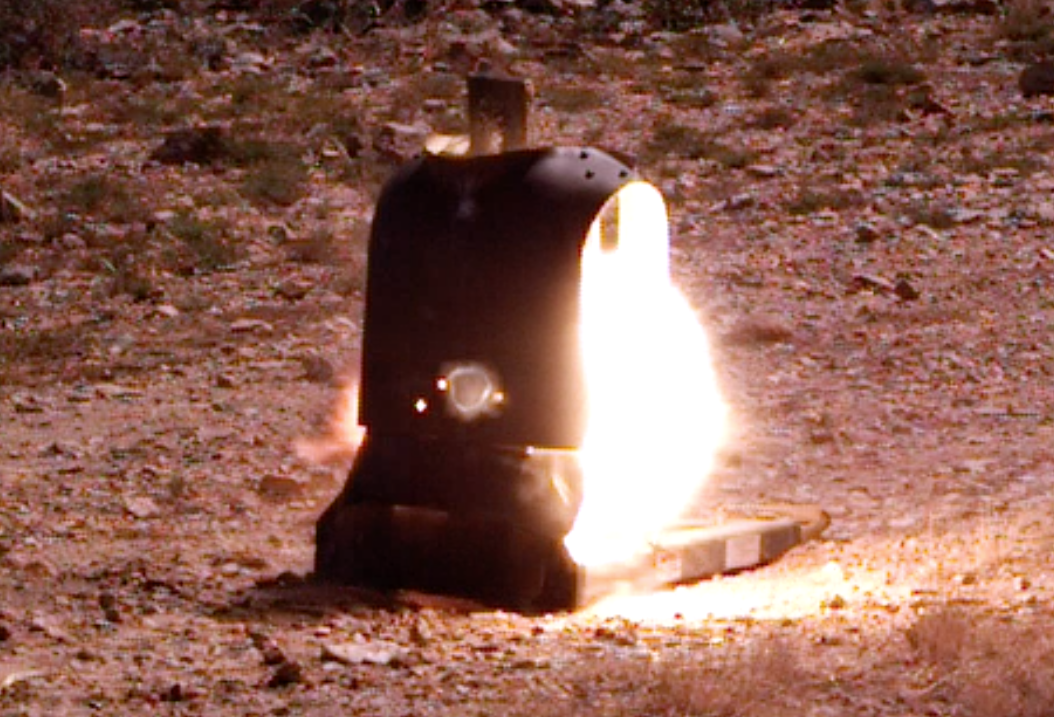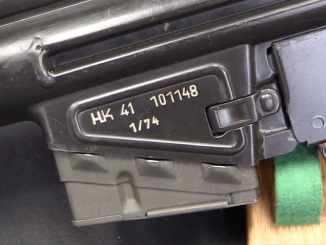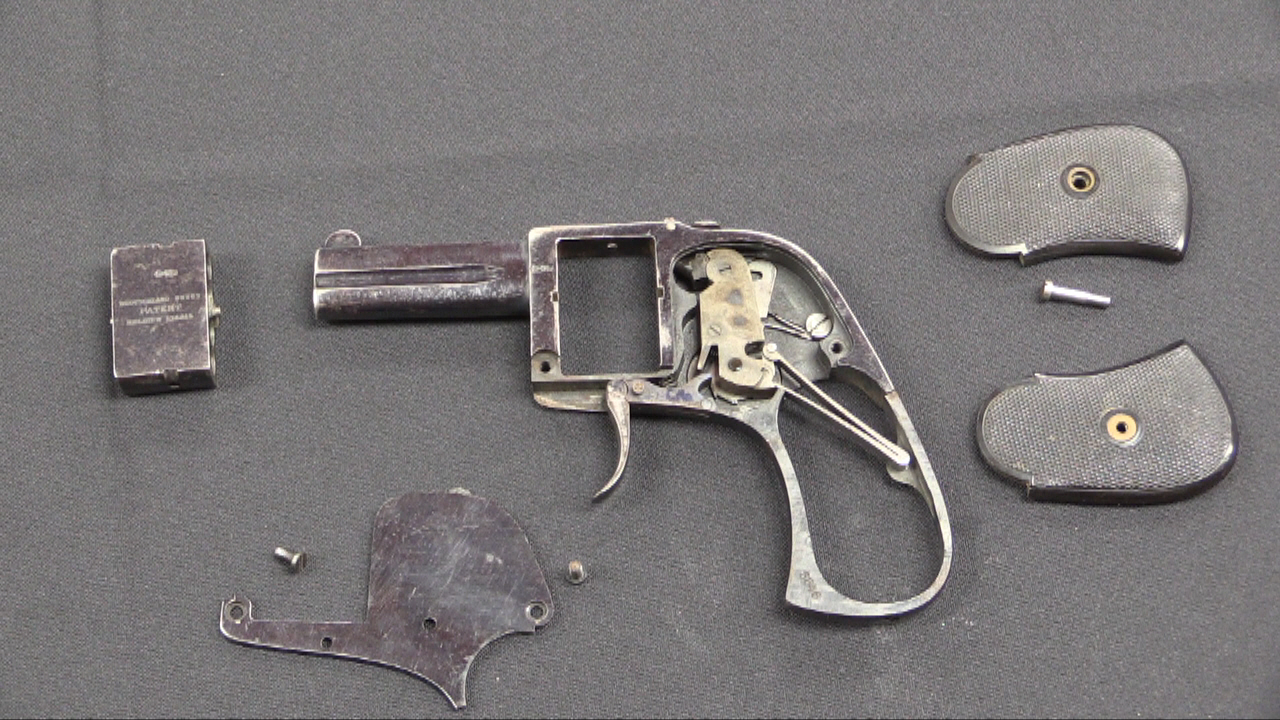In 1928 and 1929, the Swiss Rheinmetall company produced about 50 examples of a toggle-locked rifle designed by Karl Heinemann. It was tested by the United States among other countries, but never found military acceptance. This particular example is a Heinemann rifle in sporting pattern, made by the Walther company. I do not know the details of Heinemann’s move from Rheinmetall to Walther, but I would guess it had to do with his early rifles’ lack of military success.
Mechanically, the gun is quite unusual and interesting, with a toggle-locked bolt and a Bang-type muzzle cup. Gas is captured in this cup when the rifle is fired, and that pressure pulls the muzzle cup forward. An operating rod runs from the muzzle back to a cam which cracks the bolt toggle open when it is pulled forward, thus unlocking the action.




В.Е. Маркевич in Ручное огнестрельное оружие describe both rifle, separately as Automatic rifle system Rheinmetall model 1928 and Automatic rifle system Heinemann model 1928. According to this book:
Rheinmetall rifle existed in 7mm and 7.92mm (both Mauser) and weight 3900g and 4500g respectively. 2 magazine sizes exist: 5-round and 25-round. Fire single shot only. Automatic of this rifle was unsatisfactory, so it was abandoned.
Heinemann rifle was only 7.92mm Mauser, has 5-round or 10-round magazine, weight was 4500g. Due to its mass, construction and unsatisfactory working it was unsuitable for military usage. Toggle lock is more complicated, heavy and has shorter service life than, for example, locking by tilting as in Czechoslovak «Z. H.» rifle.
(Z. H. mean ZH-29 or «Z. H.» model 1929 as it is called in this book)
It almost looks like an attempt at a self cleaning Bang system. If the cartridge used a heavy charge of slow burning powder this could be helpful.
Oh, this is like dream; beautiful mechanics, splendid finish. By showing this I believe we have complete scope of toggle action.
It is beautiful. Even with Versailles reparations to pay and on the eve of hyper inflation and the dark days of national socialism – Those guys could still design and build beautiful rifles
Ian might yet bring us more variations on the toggle theme.
we haven’t seen a direct gas impingement toggle, or a blow forward toggle yet.
I wouldn’t expect them to come from anywhere as stayed straight laced as the toggles that we’ve seen so far, Switzerland, America, Germany and Japan aren’t particularly known for brightly coloured mushrooms or exotic herbs…
Ok, perhaps Weimar Germany did produce some interesting cabaret acts, but it takes somewhere like Italy or France to produce really psychedelic engineering.
It is worth noting that it is also atypically un-German in sense of elegance.
When looking at it, one item came back to me. If you recall about year and something ago we discussed finishes and their coloration/ sheen. I can see this gun has it too – kind of deep purple (I do not refer to rock band) tinge. Gorgeous.
Now I go into your next memo.
“really psychedelic engineering”
The distance between insanity and genius is measured only by success. (Tomorrow Never Dies)
Apologies Denny,
I don’t recall ever seeing a picture of an actual example of the Pistol, and can’t remember if this may be how the Potato digger works as well.
But, one of the three consecutive US patents for automatic pistol mechanisms that J M Browning took out in 1897 – included one for a direct gas impingement toggle – US Pat 580,923
the other two were for the swinging barrel that he actually ran with, and a rotating barrel.
The guy was a Mormon, so unless he was breaking with his faith, I can’t invoke mushrooms, smoke or other mind bending substances.
Then again, I’ve never had to sit through a Mormon sermon.
http://pdfpiw.uspto.gov/.piw?docid=00580923&PageNum=2&IDKey=9919724E86BD&HomeUrl=http://patft.uspto.gov/netacgi/nph-Parser?Sect1=PTO1%2526Sect2=HITOFF%2526d=PALL%2526p=1%2526u=%25252Fnetahtml%25252FPTO%25252Fsrchnum.htm%2526r=1%2526f=G%2526l=50%2526s1=0580,923.PN.%2526OS=PN/0580,923%2526RS=PN/0580,923
I have not seen this one before. Was it aver produced and tested? Yes, I kind of feel the guy could have been on ‘mushrooms’ at the time; truly Mormonic device (sacrilege disclaimer).
The dainty nature of links f7 & f11 makes me wonder it this was ever constructed and survived couple of cycles.
At least one prototype was built by Browning himself, and demonstrated to John H. hall and Carl J. Ehbets of Colt at the Colt factory (Hartford, CN) on 3 July 1895. It is now in the Aberdeen Proving Ground Museum collection;
http://www.sightm1911.com/lib/history/1895.jpg
Overall length is 216 mm, barrel length 146 mm, weight 964 grams, seven-shot box magazine. It fired a .38 caliber cartridge that later “evolved” into the .38 ACP (9 x 23SR).
The reciprocating bolt was operated by a connecting rod attached to the gas piston lever. It was loaded by grasping the head of the lever, pulling it up and back, and letting go of it.
When it fired, the bullet passed the gas port 102mm ahead of the leade’, and gas pressure flipped the lever up against its return spring. In other words, the same system as the Model 1895 Colt “Potato Digger” machine gun, just turned upside down.
(Ref; Ezell, Handguns of the World, p.203-205.)
cheers
eon
Thanks Eon.
I’m just trying to get my head around what an upside down potato digger might be better described as?
apple picker?
ok, maybe not “nose picker” however appealing that activity might become during a long and very boring sermon.
I just checked out, Ian has a high res photo gallery and a manual for the 1895 colt/marlin potato digger
https://www.forgottenweapons.com/light-machine-guns/colt-1895-potato-digger/
This is remarkable recollection Eon.
I should add that I have tremendous respect for J.M.B. and the previous note should be taken with reserve. I like to ‘fool around’ given opportunity and taking on pitch Keith threw up – it’s fun. I believe nothing human should be taken too seriously.
Denny;
It’s not so much that I have “remarkable recollection” as that I have a large library and know where to look things up.
😉
cheers
eon
“I have tremendous respect for J.M.B.”
In early 20th century and inter-war period there were places in Europe where Browning (sometimes in form: Brauning) was synonym to automatic pistol and was applied to guns which were not linked to him anyway.
Probably only him and Samuel Colt achieve it (with name of later sometimes applied to any revolver, independent from its relation of lack of relation to Colt)
Full patent including drawings, description and cites at: http://pdfpiw.uspto.gov/.piw?PageNum=0&docid=00580923&IDKey=9919FCC286BF&HomeUrl=http%3A%2F%2Fpatft.uspto.gov%2Fnetacgi%2Fnph-Parser%3FSect1%3DPTO1%2526Sect2%3DHITOFF%2526d%3DPALL%2526p%3D1%2526u%3D%25252Fnetahtml%25252FPTO%25252Fsrchnum.htm%2526r%3D1%2526f%3DG%2526l%3D50%2526s1%3D0580923.PN.%2526OS%3DPN%2F0580923%2526RS%3DPN%2F0580923
Ian, can you in the header include link to video, so its easy to go to F30 and like?
According to Barnes, there weren’t any actual 10.5 mm bore cartridges suitable for this sort of action; the ones that existed were rimmed, black-powder rounds.
The 262 grain bullet weight eliminates the 10.75 mm rimless, smokeless-powder rounds, generally, as they were never loaded with bullets lighter than 300 grains.
This leaves us, bore designation or no, with the 9.3 to 9.5 mm rounds, of which most were rimless, bottlenecked, smokeless-powder loads with bullets in the 230 to 290 grain range.
A chamber cast would tell for sure, but the most likely “culprit” would be either the 9.3 x 62 Mauser (285-gr. @ 2360= 3544 FPE) or 9.3 x 64 Brenneke (262-gr. @ 2768 = 4465 FPE). The latter factory load seems to be “dead on” the specification, in fact.
John Taylor rated the 9.3 Brenneke right alongside the .375 H & H for heavy African game. And a fast-firing semi-automatic in such a heavy caliber would have been an entirely reasonable arm for “walking up” some of the more obstreperous wildlife in those parts.
cheers
eon
“….9.3 x 64 Brenneke”. That makes sense, Eon.
Brenneke brand (origin) is still very popular with European hunters. I have seen 6.5 x 64 at time of my last visit. It makes super deer calibre.
Brenneke is brand from name of this Herr:
https://en.wikipedia.org/wiki/Wilhelm_Brenneke
He not only developed new cartridge like 7x64mm or 9.3x64mm but also new projectiles – TIG i.e. Torpedo Ideal Geschoss and later TUG i.e. Torpedo Universal Geschoss, which despite being over 80 year old design are still used by German hunters.
Thank you for being my personal checker, Daweo. 🙂
You are right in that how gun-tech ignorant people call them. I even recall name “parabola” for P08 which I wholeheartedly disdained.
“I even recall name “parabola” for P08 which I wholeheartedly disdained.”
Other incorrect name for this gun was “gesichert”
“This leaves us, bore designation or no, with the 9.3 to 9.5 mm rounds, of which most were rimless, bottlenecked, smokeless-powder loads with bullets in the 230 to 290 grain range.”
I would add 9.3×57 Mauser (not to be confused with 9×57 Mauser):
http://www.municion.org/9_3x57M/9_3x57M.htm
which is simply 7.9×57 necked up
It and its near-twin, the 9.5 x 57 Mannlicher-Schoenauer (the two are not interchangeable, however), both had roughly the ballistics of the modern .358 Winchester.
Not heavy enough for African heavy game but more than adequate for camp meat there, and definitely more than adequate for anything in Europe.
In North America, they would handle anything east of the Mississippi, and most things west of same except possibly elk or the larger bears.
cheers
eon
” 9.5 x 57 Mannlicher-Schoenauer”
According to KYNOCH data available here: http://www.hoferwaffen.com/hofer_55.php?lang=en
9·5 mm. Mannlicher-Schönauer Rifle
POWDER: 45 grs. Smokeless
BULLET: 270 gr. Metal-Covered
MUZZLE VELOCITY: 2,200 Ft. per sec.
ENERGY: 2,905 Ft. lbs.
VELOCITY @ 100 yards: 1,914 Ft. per sec.
ENERGY @ 100 yards: 2,195 Ft. lbs.
As I thought about it (sometimes yesterday) bit more, I came to conviction that this particular rifle along with first of Japanese toggle action rifles (Kawamura?) is actually NOT true gas operated, but gas initiated blow-back.
When I look specifically at this German beauty and realizing that the gas trap is at very end of barrel and even with delay (due to spring and mass of rod plus free rod run) was able to produce sufficient recoil energy, it tells me that there must have been plenty of residual pressure left in the barrel to complete the cycle.
There is a theory on this phenomenon which is quantified by Villier’s formula.
Well put. Kawamura’s rifle has the advantage of a smaller operating rod and piston, plus his rifle’s piston allowed gas to exhaust openly as opposed to having the gas and propellant residue forced back into the rifle barrel. The Bang system is prone to clogging and the vent holes don’t seem to be a good idea in muddy conditions.
Had Heinemann’s rifle and Kawamura’s rifle development continued with some improvements to make them less prone to clogging and if they were successfully chambered for big game hunting ammunition, one might be tempted to purchase a few as designated marksman’s rifles (with a slight anti-armor capability to boot, assuming we’re talking about lightly armored vehicles or idiots misusing trench armor).
Did I mess up?
Hmmm, you say clogging and that may be so.
What I see on this sample is relatively good access to trap and its cleaning. Times before I did not really appreciate this approach to operation, but under last impression I revised that view.
“(with a slight anti-armor capability to boot, assuming we’re talking about lightly armored vehicles or idiots misusing trench armor)”
Russian has developed AP version of 9.3×64 Brenneke
http://weaponland.ru/board/patron_93x64/38-1-0-418
pierce 10mm of steel plate at distance 200m (80% or more chance of piercing)
“if they were successfully chambered for big game hunting ammunition”
Normal toggle-lock (Adolf Furrer version) proved to be up-scalable even for artillery size shells, see 24 mm Tankbüchse 41:
https://de.wikipedia.org/wiki/24_mm_Tankbüchse_41
on the other hand I fear that any new cartridge differing in size might need different toggle and/or sizes (diameters) of “gas-operated” part.
Heinemann seems to have been a prolific designer – if number of patents is any guide:
http://worldwide.espacenet.com/searchResults?AB=&AP=&CPC=&DB=EPODOC&IC=&IN=Karl+Heinemann&PA=&PD=&PN=&PR=&ST=advanced&Submit=Search&TI=&locale=en_EP&sortField=prd&ascending=true
variously assigned to DWM and Rheinmetall
Here’s the US patent for this particular rifle http://worldwide.espacenet.com/publicationDetails/originalDocument?CC=US&NR=1725272A&KC=A&FT=D&ND=3&date=19290820&DB=EPODOC&locale=en_EP
there was a very nice striker fired falling block amongst those patents too
It looks like the top link needs some playing with in order to get the results to display correctly by priority date and in ascending order.
These are two US patents for the possible arrangements of the (coil) recoil spring at the rear of the toggle:
http://worldwide.espacenet.com/publicationDetails/originalDocument?CC=US&NR=1825904A&KC=A&FT=D&ND=3&date=19311006&DB=EPODOC&locale=en_EP
http://worldwide.espacenet.com/publicationDetails/originalDocument?DB=EPODOC&II=20&ND=3&adjacent=true&locale=en_EP&FT=D&date=19310428&CC=US&NR=1802422A&KC=A
Stripper loading for what looks like a side mounted mag, but also showing the arrangement of the extractor: http://worldwide.espacenet.com/publicationDetails/originalDocument?DB=EPODOC&II=22&ND=3&adjacent=true&locale=en_EP&FT=D&date=19310811&CC=US&NR=1818890A&KC=A
Thanks for digging out all those sources, Keith.
It must have taken pile of your spare time; much appreciated!
It is a beautiful rifle, so well made from the finest steel in a way you don’t see any more. But it must have cost an absolute fortune to make, and sadly, I expect that must be the reason behind its demise. We would all like a Bugatti, but most of us have to settle for a Ford.
With a folding space spreading high about the recoiling axis, toggle locks should suit little into the needs of auto loading firearms category. Fritz Walther’s toggle locked shotgun of 1920’s should be nearly the best in this approach since all toggle movements being solved inside space of the gun’s receiver.
As far as I know, Heinemann was the designer of the (DWM) Parabellum machine gun, which was a scaled down Maxim mechanism in an effort to save weight. It was used in airships and possibly aircraft, but too sensitive for ground use.